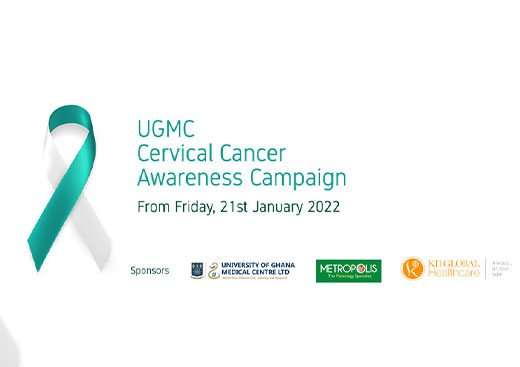
According to WHO estimates, a woman dies every two seconds from cervical cancer and in Ghana, it is the leading cause of Gynaecological deaths. Yet the Disease is curable when diagnosed and treated early.
Cervical Cancer Awareness month is celebrated globally every year in January. At the University of Ghana Medical Centre (UGMC), the campaign was launched on 21st January 2022 by the Centre’s Reproductive Health Unit (Obstetrics &Gynaecology Department) in collaboration with the Public Health Department with support from the Public Relations Department.
In his welcome address, Dr. Kwame Anim Boamah, the Director of Medical Affairs at UGMC stressed on the need for women to get screened for cervical cancer since it was the 2nd most common cancer in women in Ghana. He stated that when detected early, the Disease could be prevented from spreading to other parts of the uterus and prevent women from premature death.
Reproductive Health Nurse at the UGMC, Ms. Priscilla Dunyo who delivered a lecture on the importance of screening for the Disease as a preventive tool, explained that cancer in general, was the abnormal (uncontrolled) growth of cells that could spread and invade surrounding tissues and so cervical cancer was the abnormal or uncontrolled growth of cells on or around the cervix that if not detected early and treated, could spread to other tissues such as the womb and wreak havoc.
According to Ms. Dunyo, global estimates in 2020 indicate that approximately 604,127 women worldwide were diagnosed in that year alone, with 341,831 of them dying and 90% of the deaths occurring in less developed regions of the world. Specifically, in Ghana, she stated that 2,799 women were diagnosed in 2020 with 1,699 (60%) dying in the same year. She added that it was also the leading cause of gynaecological deaths in Ghana. She explained that 99.7% of cervical cancer cases were caused by persistent infection with Human Papilloma Virus (HPV) and a little over 70% of cervical cancers were caused by strains 16 and 18 of the HPV adding that cervical cancer in itself was rare without an individual having a high risk HPV infection.
Ms. Dunyo also explained that the two main modes of transmission for the Disease were firstly through sexual contact (although genital HPV infections could result from non-penetrative sexual contact) and secondly, through non-sexual contact such as mother to new-born (vertical transmission) and fomites (transmission through undergarments, surgical gloves and instruments). She indicated that although condom use could help reduce the risk, it does not fully protect against HPV.
Speaking on those at risk for the Disease, she said that persons who experienced sexual intercourse at an early age, individuals with multiple sexual partners, having a male partner who has had previous partner (s) infected with HPV, exposure to nicotine (smoking), immunosuppressed individuals and persons with genital infections such as chlamydia were all at risk. She also stated that some of the most common signs and symptoms of cervical cancer included abnormal vaginal bleeding and bleeding in between periods, bleeding after sexual intercourse, bleeding in post-menopausal women, smelly vaginal discharge, vaginal discharge tinged with blood, pelvic pain, vaginal discomfort with or without sexual intercourse and pain on urination.
Ms. Dunyo also stated that cervical cancer could be avoided or prevented through the modification of sexual behavior whereby the transmission of HPV could be prevented as well as through screening, detection/diagnosis and treatment of early “disease” that could progress to cancer.
She spoke on the availability of vaccines which can be used to prevent cervical cancer from developing such as Cervarix and Gardasil at the UGMC. With regard to eligibility for vaccination, she said that it was advisable for adolescent girls and boys between the ages of 9-14 years to get vaccinated before they were exposed to HPV. Also, women between 15-26 years who had never received the HPV vaccine as well as women aged between 27-45 who test negative for HPV, were also eligible for vaccination. The method of screening for cervical cancer is by Cytology (Pap Smear), HPV testing or Co-testing (pap smear and HPV). She advised that women should get screened every 3 years for the pap smear and every 5 years for the HPV once they test negative for HPV.
A 75-year-old cervical cancer survivor for 17 years by name Madam Josephine D. Djahlin shared her experience with the Disease and encouraged all women to get screened.
In his speech to launch the Cervical Cancer Awareness Campaign, the CEO of UGMC, Dr. Darius Osei stated that the Centre was committed to the global vision of ending cervical cancer by 2030 hence its commitment towards screening women for the Disease as well as of providing the vaccines at discounted rates.
Representatives of sponsors of the launch, Metropolis Medical Laboratory and KG Global Healthcare took the opportunity to introduce their respective organizations to the audience.
Closing remarks were delivered by the Director of Nursing and Midwifery Services, Mrs Judith Asiamah.